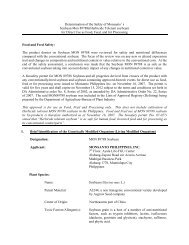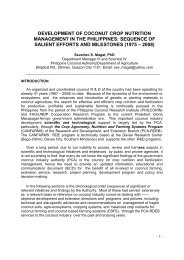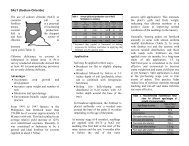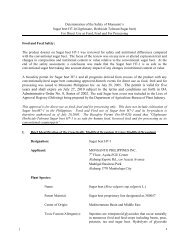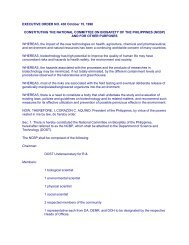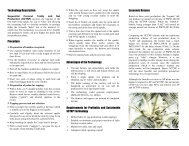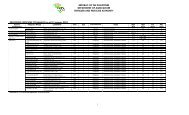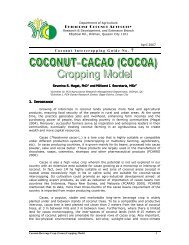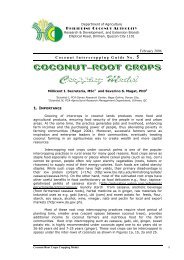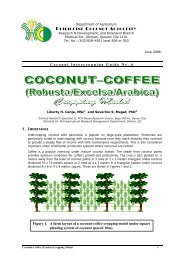2009 Annual Reports - Bureau of Fisheries and Aquatic Resources
2009 Annual Reports - Bureau of Fisheries and Aquatic Resources
2009 Annual Reports - Bureau of Fisheries and Aquatic Resources
You also want an ePaper? Increase the reach of your titles
YUMPU automatically turns print PDFs into web optimized ePapers that Google loves.
ANNUAL REPORT <strong>2009</strong>“Reeforestation”A combination <strong>of</strong> thewords ‘reef’ <strong>and</strong> ‘forest’,‘reeforestation’ entailed theseeding or placement <strong>of</strong>giant clams in pre-identifiedmicro-sites about 10 feetunderwater <strong>and</strong> enhancedwith coral transplantation t<strong>of</strong>orm an underwater scenicspot called a clam garden.The giant clam gardenwas established near Palauiisl<strong>and</strong>, a 15-minute boatride from the San Vicenteport in the town <strong>of</strong> Sta. Ana,Cagayan.A very first project <strong>of</strong>such type in region 02,‘reeforestation’ is intendedto increase fish population<strong>and</strong> at the same time <strong>of</strong>fera unique attraction fortourists.The project is a jointundertaking between theCagayan Economic ZoneAuthority, Department <strong>of</strong>Tourism RO2, Department<strong>of</strong> Environment <strong>and</strong> Natural<strong>Resources</strong> RO2, <strong>Bureau</strong><strong>of</strong> <strong>Fisheries</strong> <strong>and</strong> <strong>Aquatic</strong><strong>Resources</strong> RO2, PhilippineNavy <strong>and</strong> non-governmentorganizations.The clam garden willfunction as a habitat as thetransplanted corals <strong>and</strong> algaethat will grow on the shells <strong>of</strong>the giant clams will attract other marine species.Also, there will be an increase in fish population asproject beneficiaries learn to protect the site.Around 125 pieces giant clams belonging to threedifferent species (Tridacna squamosa, T. crossea, <strong>and</strong>T. maxima) were tagged <strong>and</strong> ‘embedded’ in the microsites in clusters <strong>of</strong> 10 to 30 pieces per hill. Brokencoral fragments were likewise gathered from nearbysites <strong>and</strong> attached to steel rods or any substrate t<strong>of</strong>orm the coral garden.The clam seeds were gathered by volunteerdivers from nearby areas.Likewise, having giant clams relatively closeMrs. Chen Mencias checks giant clamsbeing tagged prior to the seeding activity.Giant clams for the seeding activity.Volunteer divers from NGOs lead the seeding<strong>of</strong> giant clams on a semi-sheltered area nearPalaui Isl<strong>and</strong> <strong>of</strong>f Sta. Ana, Cagayan.with one another will als<strong>of</strong>acilitate reproduction asthese giant mollusks, thebiggest in the world, areknown as “free spawners.”That is, mature individualssimultaneously secrete eggs<strong>and</strong> sperm (gametes) afterwhich “chance encounter”will occur in open water.On the other h<strong>and</strong>,the project exemplifiesthe “vacation – volunteer”approach on tourismdevelopment by servingas venue to increaseawareness <strong>of</strong> touristswhich hopefully will inspirethem to work towards itsprotection.“StrengtheningGovernance &Sustainability <strong>of</strong>Small-scale <strong>Fisheries</strong>Management inthe Philippines: AnEcosystem-based<strong>Fisheries</strong> ManagementApproach”The above study is acollaborative projectbetween the Department <strong>of</strong> Science <strong>and</strong> Technology,BFAR RO2, WorldFish thru the <strong>Bureau</strong> <strong>of</strong> AgriculturalResearch, CAVAPED (NGO) <strong>and</strong> LGUs encompassingthe municipalities <strong>of</strong> Buguey, Sta. Teresita, Gonzaga<strong>and</strong> Sta. Ana in the province <strong>of</strong> Cagayan.The study entailed assessment <strong>of</strong> thebiophysical characteristics <strong>of</strong> coastal resources,analysis <strong>of</strong> policy <strong>and</strong> governance, <strong>and</strong> determination<strong>of</strong> socio-economic status <strong>and</strong> how these factors affectthe small-scale fisheries in the target municipalities<strong>of</strong> Buguey, Sta. Teresita, Gonzaga <strong>and</strong> Sta. Ana. Theresult <strong>of</strong> the study serves as reference or/<strong>and</strong> basisfor ecosystem management.11



